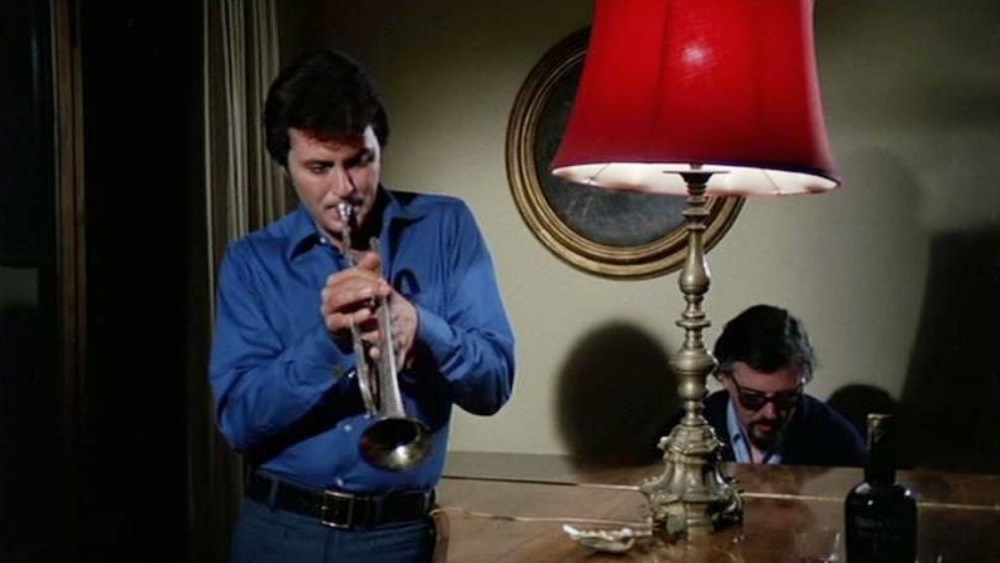VENUS IN FURS. A psychedelic horror like jazz improvisation

The Spanish master of B movies directed nearly 180 films, but many experts and fans of his work believe that the best among this extensive collection is Venus in Furs.
Jazz trumpeter Jimmy Logan is performing in Istanbul. Under the influence of LSD, he wanders along the beach when the sea washes up the body of a dead woman. Jimmy recognizes her as Wanda—a socialite ritually murdered before his eyes by playboy Ahmed Kortobawi, art dealer Percival Kapp, and photographer Olga. The shock of discovering the body prompts Jimmy to flee from Turkey to Rio de Janeiro, where he finds work in a nightclub and gets involved with a singer named Rita. One evening at the club, a mysterious girl named Venus appears, dressed in a fur coat and looking exactly like Wanda. Jimmy falls in love with Venus and takes her to Istanbul, where Kortobawi, Kapp, and Olga soon die under mysterious circumstances. Who is Venus really? An angel of vengeance, Wanda’s ghost, or her twin sister exacting bloody revenge on the tormentors?

Jesús Franco conceived the idea for Venus in Furs after a conversation with Chet Baker. The American jazzman revealed to the Spanish director that during trumpet solos, he often fell into a kind of trance, feeling as if he were guided by an invisible muse. Franco created the character of a black jazz musician who meets an enigmatic white woman, but the concept faced resistance from the producers at Commonwealth United Entertainment. They believed that the mass audience would not accept an erotic relationship between a black man and a white woman, and forced Franco to make appropriate changes to the script. Franco then made the protagonist a white jazzman but paired him with a black partner. This configuration was no longer problematic for the decision-makers at CUE and their double standards.
The producers also changed the original title, Black Angel, to Venus in Furs to evoke associations with Venus in Furs, the popular 1870 novella by Leopold von Sacher-Masoch. Franco argued that his script had nothing to do with the mentioned book (which was also adapted by Massimo Dallamano in the same year!), but ultimately relented. To make the new title of the film (screened in many countries as Paroxismus, further complicating the matter) somewhat sensible, Franco dressed Maria Rohm—the actress playing Wanda/Venus—in a stylish fur coat, and the soundtrack included the song Venus in Furs sung by Barbara McNair, who played Rita. The main role of Jimmy Logan went to James Darren, with Dennis Price, Margaret Lee, and Klaus Kinski in his typical villainous cameo.
Another intervention by the CUE executives involved a voice-over narration, written by American screenwriter Malvin Wald. This technique, on one hand, gave Venus in Furs a noir flair, but on the other, it disrupted the overall mood, which was closer to a horror film than to film noir. Moreover, since the production of the film took place at the end of the 1960s—a time of flower children, free love, drugs for everyone, and everything psychedelic—the financiers decided to further “enhance” (or “weirdify”) it visually. Some scenes were shot in slow motion, with vivid colors and a sunlit effect. Citing appropriate sources, Troy Howarth in his monograph Real Depravities: The Films of Klaus Kinski, argues that all these treatments were the producers’ ideas and were in clear opposition to Franco’s intentions.

The idea of extensively using jazz music on the Venus in Furs soundtrack came from the Spanish director himself. Franco, a private jazz enthusiast and connoisseur, hired the British fusion band Manfred Mann Chapter Three to compose the music (in addition, the director himself and band members appeared in the film as musicians accompanying Jimmy). Besides their compositions, the soundtrack also features tracks by Syd Dale, Stu Phillips, Bruno Nicolai, Keith Mansfield, and the previously mentioned Venus in Furs song performed by Barbara McNair. For over half a century, the music for Venus in Furs was not available in its entirety on any official media—only five years ago, extensive fragments of the soundtrack to Franco’s film were released on the Manfred Mann Chapter Three compilation Radio Days Vol. 3 – Live Sessions & Studio Rarities.
Music is a key element of Venus in Furs—the film is almost entirely accompanied by excellent jazz, with acting sequences interspersed with performances by Manfred Mann’s band. Additionally, the film itself resembles a jazz composition with a main theme and surrounding variations and repetitions. This is also a characteristic feature of Franco’s work, who used to treat the narrative of his films in a loose manner, somewhat reminiscent of dream logic. It is no different in Venus in Furs: it remains uncertain until the end whether the story is a dream, hallucination, drug vision, or post-mortem journey through the afterlife. In another case, such a lack of literalness and concreteness might be considered a flaw. But not this time: the strength of this astonishing film lies not in its plot, but in its dreamy rhythm of jazz improvisation. Worth watching, worth listening.

